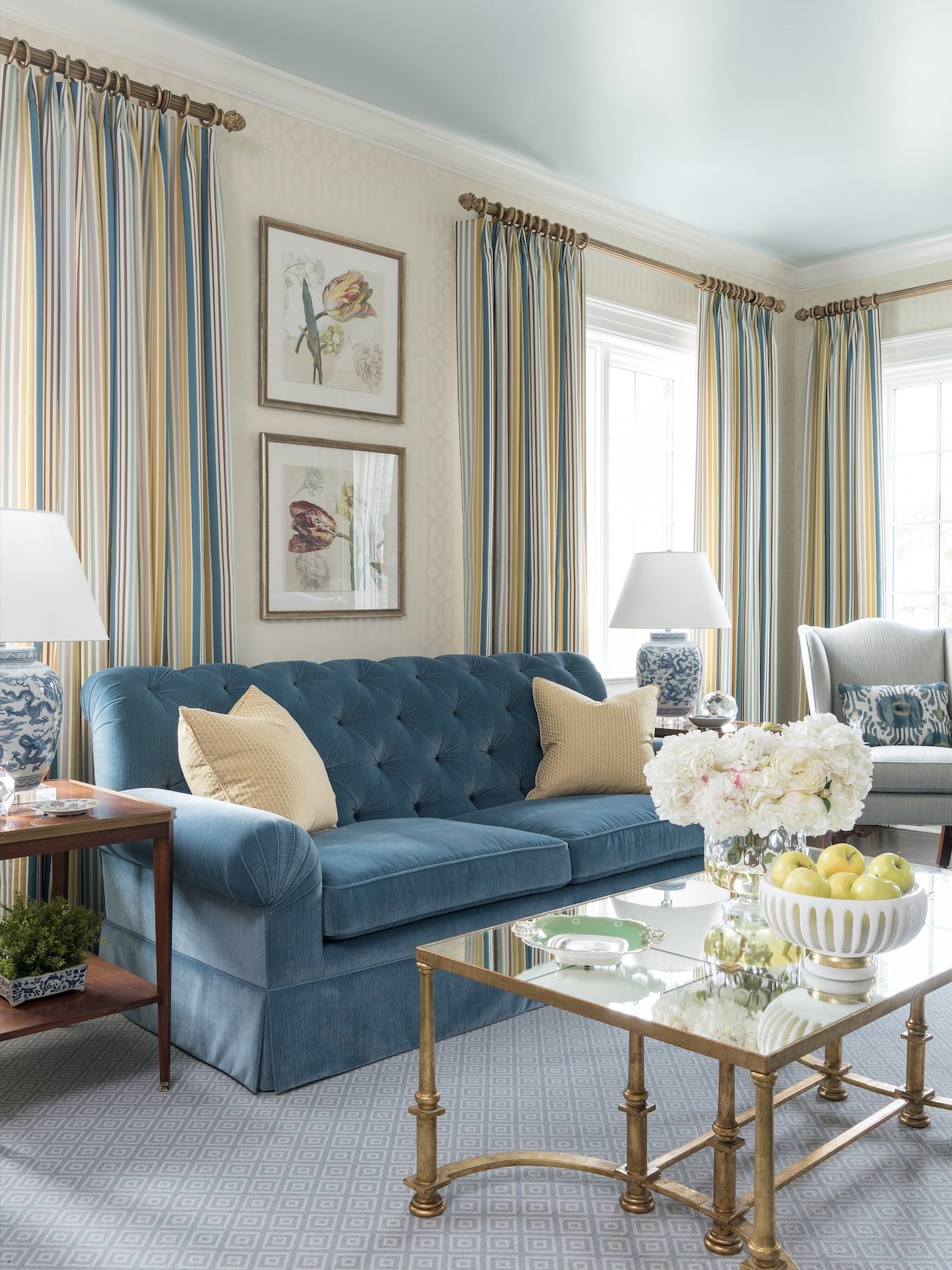This blue sofa with yellow throw pillows perfectly matches the colors we chose for this SMU Theta sorority house in Dallas.
Sofas are one of those “anchor pieces” that define the look of the whole room. Since they aren’t inexpensive, you’ll want to find one that you can enjoy sitting on and looking at for years to come. Following is a checklist of four things that I, as an interior designer, would suggest that people keep in mind as they shop.
1. Scale
Consider the different ways that you sit or lounge on a sofa. Do you like to sit with your legs up? Make sure that the sofa is deep enough to accommodate. Do you lie down sometimes? Your sofa will need to be long enough for you to stretch out. If you’re tall, you may also want to look for a sofa with a higher back for better back support. For couples, sofas that are between 80-90 inches are an appropriate width. Families should seek sofas that are 90 inches or wider.
Sectionals look best in large rooms, so for a small living room, I would recommend a pair of two-seater sofas instead. That way, you don’t have a large block of the same color fabric dominating one side of the room.
Sectionals, like the gray L-shaped sectional we used in this Kessler Park den, look best in large rooms.
When you’ve found a sofa that you like, try cutting out the shape of it from newspaper and placing it on your floor to serve as a visual guide. Check to see if you have enough space to walk around it and that any open doors or shelves won’t swing into it. Measure your doorways too to make sure you can fit your newest purchase into the house. If you’re going to have difficulty getting a sofa into the house, you can look for sofas with a low back style or removable legs, or modular sofas that can be brought in piece by piece.
To leave enough room for a side table, add about 20 inches of width to your measurement. You should also leave 20 inches of space between the edge of your coffee table and the front of your sofa. Don’t forget to measure the sofa’s height too, especially if you plan on having it in the middle of an open concept living space. You want the back of the sofa to be low so that it doesn’t cut across sightlines in the room.
When the seat is too low, it makes the sofa more difficult to get out of, especially as we age. 15 inches or less is considered a low seat height.
2. Comfort
For a casual living room, opt for comfortable cushions, but for a formal sitting area, you want cushions that are firm and keep their shape. Feather-filled cushions have a cloud-like feel; however, they need to be fluffed once a week to retain their shape. Foam-filled cushions are less plush, but they hold their shape better. Cushions with inner springs that are wrapped in both foam and down feathers are my top pick because they keep their crown longer.
3. Fabric
For families with small children, I suggest choosing stain-resistant outdoor fabric brands like Sunbrella or Crypton. These fabrics won’t fade in sunlight either, so they can be placed near windows. Leather is easy to clean but also scratches easily, so it might not be a good option for families with pets.
We used a combination of different upholstery textures to create variety for this seating area in a North Dallas home.
In choosing your fabric color, ask yourself: is this room intended to be calming, playful, or elegant? A colorful or patterned sofa can inject energy into a room. A neutral, solid color sofa provides harmony. Make sure to bring home a sample swatch. With a swatch, you can see how the scale of the pattern looks in your living space or how the light in the room changes the color of the fabric.
4. Style
When it comes to sofas, some people prioritize comfort over style, so they end up bringing home a sofa that looks completely out of place. It’s worth your time and money to find a sofa that matches your home and feels great.
Although it’s possible to mix different styles of furniture, the safest bet is to pick a sofa that matches the style of the rest of the room. Modern sofas often have tapered legs, track arms, block feet, and grid-tufted cushions. Traditional sofas tend to have a skirt with tape on the bottom, rolled arms, and contrasting cording. Modern sofas will be a lot sleeker, deeper, and lower to the ground than traditional sofas.
Finding the perfect sofa isn’t easy. However, arming yourself with a checklist of your top priorities will make the shopping process faster and easier. If you could use more guidance, try reaching out to an interior designer like myself. Interior designers have access to the most durable upholstery fabrics on the market. And once we see your space, we’ll know exactly what style and size of sofa will fit right in.
You can reach us by sending an email to info@chambersinteriors.com or calling us at our Dallas office: 214-651-7665.



